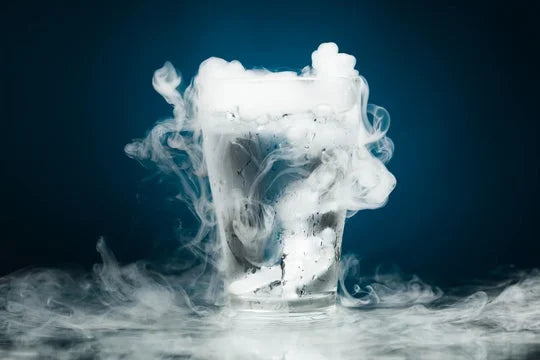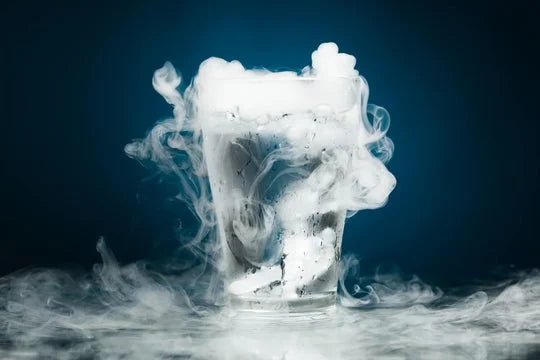Dry Ice vs. Gel Packs - Part 2: Thermal Performance

Welcome back for Part Two of our Dry Ice vs. Gel Packs comparison series. This section covers the basics related to the thermal performance of both materials.
There are actually several thermal properties that should be considered when deciding on the best coolant for the given application.
Eutectic Point: This is the point at which the material changes phase. This point can be used to approximate the temperature at which the coolant will keep the payload. In the case of gel packs, this is the point where solid becomes liquid, the melt point (0°C / 32°F). In the case of dry ice, this is the sublimation point (-78°C /-109°F) where solid becomes gas.
Dry Ice sublimates at a much colder temperature than the gel pack melt point, meaning Dry Ice will keep payloads colder. The eutectic point is important when considering the application.
|
Category |
Application Examples |
Coolant Choice |
|
Fresh (2° – 8°C) |
Fruits, Vegetables, Fresh Meats, Dairy, Certain Biologics |
Gel Packs Only |
|
Frozen (~0°C) |
Frozen Meals, Frozen Meat, |
Either or Both |
|
Sub Frozen (-10°C or below) |
Certain vaccines, Ice Cream, Certain Seafood |
Dry Ice Only[1] |
Latent Heat of Fusion or Latent Heat of Sublimation: This is the amount of energy or heat that the material can “absorb” per unit mass. You might think of this as a measure of efficiency or thermal capacity. If coolant were analogized as a battery, this would be how much charge it has.
Water based Gel Packs have a Latent Heat of Fusion of ~334 J/g, meaning every frozen gram of gel pack can absorb 334 joules (a measure of heat or energy) by thawing. Dry Ice has a Latent Heat of Sublimation of ~590 J/g.
So, every gram of dry ice sublimating absorbs 77% more heat than a gram of gel pack melting.
However, to do an appropriate comparison of the two coolants you would also have to consider the specific heat of the gel packs. If the gel pack was conditioned in typical commercial freezer (-20C) and the cut off temperature for the shipment was 8C, the gel pack would be absorbing 390 J/g[2]. Therefore, a more correct comparison would be Dry Ice absorbing 51% more heat per gram. Specific heat of the Dry Ice would not need to be considered as the CO2 gas is vented out and does not provide thermal protection after sublimation.
Said another way, to get equivalent coolant levels purely from a net heat absorption perspective, you would match ~15 lbs. of gel packs for every 10 lbs. of Dry Ice.
Rate of Sublimation / Melt Rate: This is a measure of how long the coolant is active. Melt and Sublimation rates are a function of the delta between the eutectic point and the ambient or environment temperature.
The larger the difference between the eutectic point and the ambient temperature, the more rapid the sublimation or melt rate will be. For example, the melt rate of a gel pack in a 2°C ambient environment will be very slow. The sublimation rate of dry ice in that same 2°C environment will be faster as a function of % of starting material.
At room temperature (no protective insulation) a one lb. block of dry ice may completely sublimate in 20 minutes, room temperature being very far from its eutectic point of -109°F. A frozen gel pack may last for hours at room temperature without protective insulation.
This speaks to not only the importance of insulation in packaging but also the storage and handling of the coolants during packing and fulfillment stages.
Summary
Different tools for different use cases. There are many variables and the best approach to selecting a coolant and the amount of coolant is to do testing.
Minus Works is happy to help with your cold shipping application. We have a thermal environmental chamber to facilitate scenario testing and Tag Temperature Loggers to help with field testing.
[1] Certain Phase Change Materials (PCMs) are also appropriate. Though they are not in scope of this write up, Minus Works also produces low temperature PCMs.
[2] Even after the gel pack is fully thawed, it is still offering thermal protection in its liquid state by adding to thermal mass. This is driven by the specific heat of water: it still takes a fair amount of energy (4.18 J) to heat a gram of water one degree. Dry Ice offers no additional protection after sublimation as it converts to gas and escapes the package.

